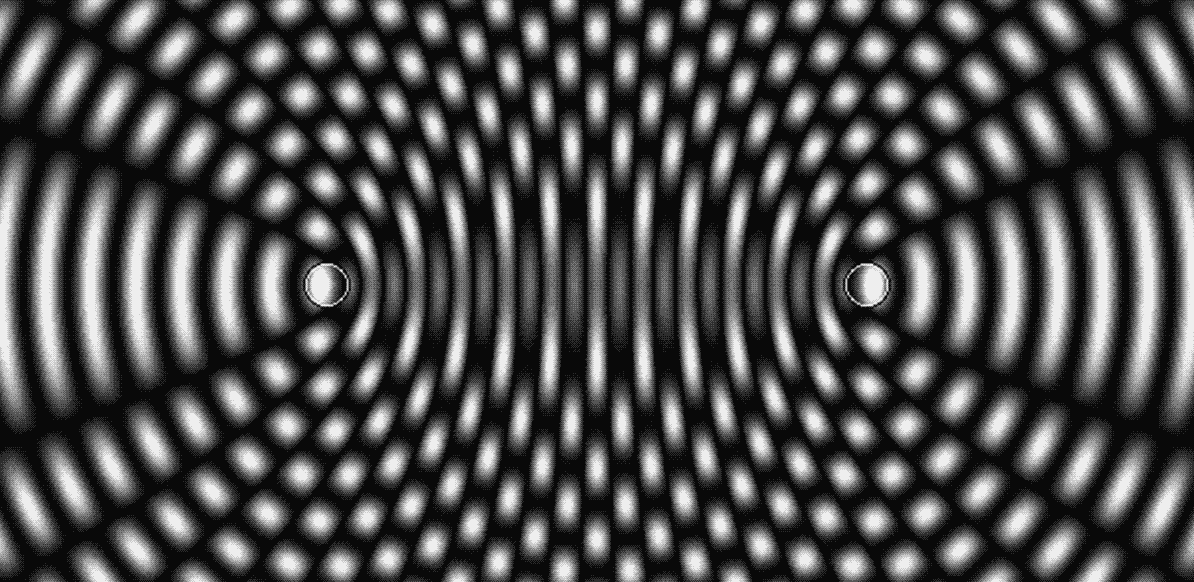
A collection of rhythmic studies produced by the combination of sinewave beat frequencies. An LP of compositions and an archive of patterns with extensive liner notes to be released in 2019.
Beat frequencies are audible interference patterns that occur between two pure waveforms or sinewaves that are very close in frequency. The volume fluctuates at the rate of the difference between the two tones, creating a tremelo-like effect. These fluctuations are an acoustic phenomena, namely occuring physically in the air. However, when individual sinewaves are introduced in isolation, one to each ear, as over headphones, we still in fact hear the beat frequency. The beats produced in this setting are called binaural, and are created by our brains. In either setting, when three or more sinewaves are combined these beat frequencies can rapidly become complex rhythms and polyrhythms. As you will see below, changing the panning of the sources of the sinewaves (e.g. left, right, or centered in space between the speakers) can also drastically change how the beat rhythm is perceived.
Study for Seven Sinewaves is an ongoing curation of the rhythmic and spatial possibilities of acoustic beat frequencies. This work is a continuation of and homage to work done in 1965 by composer Pietro Grossi at the Studio di Fonologia Musicale di Firenze. While an album of some of his original works for sinewaves was re-issued on the ANTS label, the rest of the extensive studies he completed are now lost. This work is an attempt to extend and reinvent those studies for a modern audience.
A selection of the new archive I’ve created follows. First, a single beat frequency of 1 Hz, created by sinewaves at 200 Hz and 201 Hz. The sinewaves are panned very hard to the right (R) and left (L) channels, respectively:
Next, a third frequency is added, to the right channel this time.
Frequencies: 200 Hz(L), 201 Hz(R), 202 Hz(R)
Here, the frequencies stay the same but are re-panned as follows:
Frequencies: 200 Hz(L), 201 Hz(R), 202(L)
The sequence continues, adding a sinewave with an increase of 1 Hz, and exploring variations in panning.
Frequencies: 200 Hz(L), 201 Hz(R), 202 Hz(R), 203 Hz(L)
Frequencies: 200 Hz(L), 201 Hz(R), 202 Hz(L), 203 Hz(R)
Here we add a new variable--one of the sinewaves is placed in the center (C) of the mix, allowing it to interact with both channels. Frequencies: 200 Hz(L), 201 Hz(R), 202 Hz(L), 203 Hz(C):
Frequencies: 200 Hz(L), 201 Hz(R), 202 Hz(R), 203 Hz(R), 204 Hz (L)
As more frequencies are added, the rhythms can become increasingly complex, as well as the possibilities for altering them with panning. This is an example of that.
Frequencies: 200 Hz(C), 201 Hz(C), 202 Hz(R), 203 Hz(L), 204 Hz(R), 205 Hz(L)
The current compositions and archive are designed for two channels, but a previous iteration was build for the 72 channels of the Exploratium’s Kanbar Forum in 2014. The spatial aspect of the work was especially emphasized, and visitors were able to hear a variety of polyrhythms depending on where they stood in the space--even moving one’s head could drastically alter the rhythm that was heard. The original Kanbar installation was made in collaboration with Barry Threw, using Meyer Sound’s Constellation system. For more information on the original project and the instrument built for it, go here.